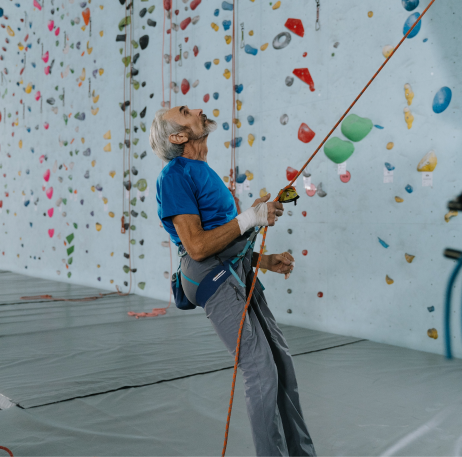Exercise is an integral part of healthy living. For people with Parkinson’s (PD), regular physical activity is particularly important as it can play a vital role in managing a range of symptoms, including gait disorders, rigidity, impaired balance, and more.
Physical benefits of exercising with PD
The concept of exercise therapy for PD isn’t new. In fact, physical exercise has been considered a form of treatment for PD for more than 60 years! Today, there’s a substantial body of research that indicates exercise – from treadmill training to Tai Chi and everything in between – can help people with PD maintain strength and independence, and may ease a wide range of symptoms.
Flexibility training
Flexibility training can also be useful for people with PD and is often recommended as a safe first step when beginning an exercise program. It’s believed that stretching can help alleviate some of the muscle rigidity that comes with PD and reduce tension. A number of studies (1) indicate that trunk flexibility can help improve balance control, functional reach distance, and walking speed, all of which can play a key role in safety, independence, and overall quality of life. Importantly, stretching exercises can be performed while seated or lying down, which minimizes the risk of injury and makes flexibility training more accessible.
Aerobic exercise
A number of studies have shown aerobic exercise can produce positive results for people with PD. In a 2007 study published in Clinical Rehabilitation (2), researchers found that regular aerobic training on a treadmill resulted in positive improvements in balance, speed, and fear of falls. In 2008, researchers investigated the effects of supervised treadmill walking three times a week for 40 minutes in patients with mild to moderate PD. At the end of the six-week study, researchers found significant improvements in lower limb functional parameters such as walking, balance and agility (3).
Strength training
It’s only been in the last 20 years or so that researchers have begun looking at the impact of strength training on patients with PD, but the results are already quite promising. Many of the general health benefits associated with strength training – including increased strength, muscle mass and bone density – are extremely beneficial to PD patients and may help counteract some of the muscle and strength loss that are common with PD (4). In a study published in the American Journal of Physical Medicine & Rehabilitation (5), researchers found that an eight-week course of resistance training resulted in significant gains in stride length, walking velocity, and postural angles compared with pretreatment values. The participants of the study, who had mild-to-moderate PD, experienced strength gains similar to the control group who did not have PD.
Balance training
Good balance is essential for mobility, which often becomes increasingly difficult as PD progresses. There are many types of sports and physical activities that can help improve balance, including:
- Water aerobics.
- Tai chi.
- Yoga.
- Dancing.
- Gardening.
- Golfing.
- No-contact boxing.
Neptune Care – A Holistic Approach
Regular exercise is just one part of staying fit and healthy with PD. Here at Orbit, we take a holistic approach to care, using digital health innovations to help you get better insight into how your exercise, diet, medication and other lifestyle factors shape your symptom control. This is why we developed Neptune Care, your personalized Parkinson’s self-monitoring and learning app.
The app enables you to get a better understanding of how your activities and treatments can affect your motor symptoms. Using a wearable device, Neptune Care passively captures your motion data to provide insights into your ON, OFF, and Dyskinesia motor states. Gain unparalleled insights into your habits and stay on top of your health with better PD management.
We’ve launched our Early Access Program where we are offering the solution free of charge to 100 eligible people living with Parkinson’s. Join the waitlist and see if you qualify today.
Sources
- Effects of a Flexibility and Relaxation Programme, Walking, and Nordic Walking on Parkinson’s Disease – PMC
- The effects of incremental speed-dependent treadmill training on postural instability and fear of falling in Parkinson’s disease – Burcu Duyur Cakit, Meryem Saracoglu, Hakan Genc, Hatice Rana Erdem, Levent Inan, 2007
- Does treadmill training improve lower-extremity tasks in Parkinson disease? A randomized controlled trial
- Associations between Brain Structural Damage and Core Muscle Loss in Patients with Parkinson’s Disease – PMC
- Resistance training and gait function in patients with Parkinson’s disease



